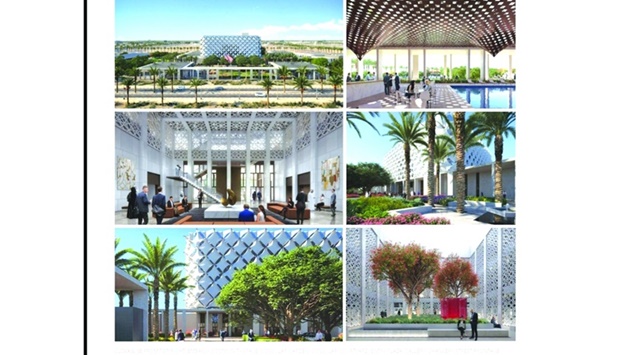The proposed new building of the US embassy in Qatar applies a number of energy efficient initiatives as well as addresses environmental responsibility with a design that invokes rich Qatari culture and American values, noted a top US official.
“The design concept of the new embassy honours the important relationship between the United States and Qatar. With Qatar’s rich cultural heritage, it will be a compelling statement to both the nations’ commitment to each other. The design applies a holistic approach to environmental responsibility and a corporate range of energy efficient strategies that address extreme seasonal conditions and enhance building performance,” said James Cuilla, project director of Overseas Building Operations (OBO), US Department of State.
__________________________________
US Embassy holds groundbreaking ceremony for new premises
__________________________________
“The project is designed to achieve LEED Silver certification by the US Green Building Council — a green building certification programme that recognises best-in-class building design and construction strategies and best practices,” he said.
He was speaking at the groundbreaking ceremony of the new US embassy premises at the new diplomatic zone in Wadi Al Banat District.
Located on a 12.3-acre site the new embassy will support the continued expansion of US–Qatari diplomatic, security, and commercial relations and will provide safe, secure, functional, and resilient facilities. The project's sustainable design, construction, and operations will represent the best of US architecture, engineering, and construction execution.
According to Cuilla, the new embassy's design evokes the rich history of Qatar and the Gulf, creating architecture that exhibits American values and responds to Qatari culture and traditions. Large shade structures inspired by traditional Bedouin tent forms, mark entry plazas, recreational areas and residential terraces.
There are stone-clad arcades, reminiscent of the historic souqs, unify the campus with shaded pathways between buildings and define outdoor court, plaza, and garden spaces.
“Recognising the importance of water to this desert enclave, the landscape design includes water features to create cooler micro-climates around the site. By visually connecting the features to the stormwater capture and irrigation systems, the landscape displays the stewardship of a coveted resource by showing the systems that make it possible,” said Cuilla.
The permanent art collection, curated by OBO’s Office of Art in Embassies, will include art in a variety of media, including painting, photography, textiles, and sculpture by both US and Qatari artists and will seek to create a dialogue of shared values between the people of both countries.
“The Chancery will include an automated building controls system, high efficiency plumbing fixtures, and a self-shading exterior shell designed to reduce solar heat gain. Photovoltaics will supply 17% of the Chancery's annual electricity use. The landscape design incorporates native, drought-resistant plants and trees that provide shade and reduce site irrigation needs. Additionally, all stormwater will be managed on site through a series of runnels and terraced basins, which will serve double duty as storage and water features,” he added.
“The design concept of the new embassy honours the important relationship between the United States and Qatar. With Qatar’s rich cultural heritage, it will be a compelling statement to both the nations’ commitment to each other. The design applies a holistic approach to environmental responsibility and a corporate range of energy efficient strategies that address extreme seasonal conditions and enhance building performance,” said James Cuilla, project director of Overseas Building Operations (OBO), US Department of State.
__________________________________
Read also
US Embassy holds groundbreaking ceremony for new premises
__________________________________
“The project is designed to achieve LEED Silver certification by the US Green Building Council — a green building certification programme that recognises best-in-class building design and construction strategies and best practices,” he said.
He was speaking at the groundbreaking ceremony of the new US embassy premises at the new diplomatic zone in Wadi Al Banat District.
Located on a 12.3-acre site the new embassy will support the continued expansion of US–Qatari diplomatic, security, and commercial relations and will provide safe, secure, functional, and resilient facilities. The project's sustainable design, construction, and operations will represent the best of US architecture, engineering, and construction execution.
According to Cuilla, the new embassy's design evokes the rich history of Qatar and the Gulf, creating architecture that exhibits American values and responds to Qatari culture and traditions. Large shade structures inspired by traditional Bedouin tent forms, mark entry plazas, recreational areas and residential terraces.
There are stone-clad arcades, reminiscent of the historic souqs, unify the campus with shaded pathways between buildings and define outdoor court, plaza, and garden spaces.
“Recognising the importance of water to this desert enclave, the landscape design includes water features to create cooler micro-climates around the site. By visually connecting the features to the stormwater capture and irrigation systems, the landscape displays the stewardship of a coveted resource by showing the systems that make it possible,” said Cuilla.
The permanent art collection, curated by OBO’s Office of Art in Embassies, will include art in a variety of media, including painting, photography, textiles, and sculpture by both US and Qatari artists and will seek to create a dialogue of shared values between the people of both countries.
“The Chancery will include an automated building controls system, high efficiency plumbing fixtures, and a self-shading exterior shell designed to reduce solar heat gain. Photovoltaics will supply 17% of the Chancery's annual electricity use. The landscape design incorporates native, drought-resistant plants and trees that provide shade and reduce site irrigation needs. Additionally, all stormwater will be managed on site through a series of runnels and terraced basins, which will serve double duty as storage and water features,” he added.


